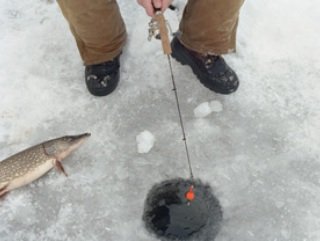 Early spring to the middle of autumn is when most anglers spend as much time on the water as they can, then hang up their tackle once the temperature drops. Yes, there's nothing quite like the warm summer air and getting that attractive raccoon tan around your eyes during the heat of prime fishing season, but what about the winter? Not to worry, as intimidating as it may be, ice fishing is actually a fun and very rewarding activity that anyone can participate in. All it takes is cold weather clothing, dedication, and some new tackle for you to overcome your cabin fever and pull in a nice limit this winter.
Early spring to the middle of autumn is when most anglers spend as much time on the water as they can, then hang up their tackle once the temperature drops. Yes, there's nothing quite like the warm summer air and getting that attractive raccoon tan around your eyes during the heat of prime fishing season, but what about the winter? Not to worry, as intimidating as it may be, ice fishing is actually a fun and very rewarding activity that anyone can participate in. All it takes is cold weather clothing, dedication, and some new tackle for you to overcome your cabin fever and pull in a nice limit this winter.
First and foremost, if you've never ice fished, and know someone who does, there is no need to spend a lot of money to try it out. Most ice anglers are ready and willing to let you use their tackle if it means they'll have company on the ice, and a possible companion for future trips. However, if you try it out and fall in love, as most first-timers do, there are a few essentials you'll need to pick up. Let's start with the obvious: winter clothing. This is a must, especially for those without a shanty (I'll get to those a little later), and can be the difference between a good day and a miserable one, not to mention the difference between warm hands and frost bite. Companies like Ice Armor, Redhead, and Celsius make dozens of ice fishing items from gloves and hats to boots and cover-alls, all designed to withstand harsh winds, water, and freezing temperatures and ensure your safety and comfort during your trip. Any outdoors retailer–Gander Mountain, Bass Pro Shops, Cabelas–will start carrying these items in late October or early November, well before the season hits
Once you're on the water, the basic equipment you'll need is a rod and reel, bait, and an auger. Companies such as Strikemaster, Eskimo, and Jiffy make several augers in manual, gas-powered or electric variations. Beginners will only want to drill a few small holes, and a hand auger with sharp blades will do fine. Like any piece of equipment, auger blades will need to be sharpened or replaced depending on their usage. You'll also want to pick up a skimmer to scoop ice chunks from the drilled hole.
Late in the fall, you can find ice fishing combos anywhere that sells fishing tackle and some even come with basic jigs and lures for casual anglers or first-timers. The action and length of the rod will vary depending on the species of fish you'll be targeting. Most fall within the two-foot range, and most anglers will opt for very light ice fishing line, which most companies make in smaller spools. Ice fishing jigs come in hundreds of styles, all of which will work just fine paired with scented plastic baits or live wax worms and jigged in the strike zone. There are, of course, other types of lures such as spoons and Rapala's Jigging Rap lures, made to entice larger species. Just like any other lure, experiment with different colors and scents until you find the one that works for you.
Beginners will be fine with that basic tackle, but will also need a seat. Most prefer a five-gallon bucket turned upside down or fitted with a seat with a small hole so that, when turned upright and sat on, provides access to store fish as you catch them. There are even heated seats for anglers who want a little added comfort.
The items described above will go a long way to ensuring that your first few trips out on the ice will be rewarding. Remember to be patient, experiment with different depths and don't be afraid to move to a new spot if you haven't had any action after fifteen minutes or so. Oh, and most importantly, wait until the ice is a good three or four inches thick before venturing out. Nothing will ruin the experience faster like falling into freezing water.
Keep a look out for my next ice fishing article, in which I'll break down what you'll need if you decide to make ice fishing an annual activity.








